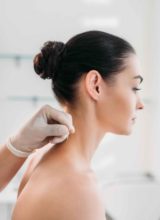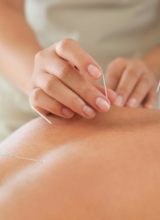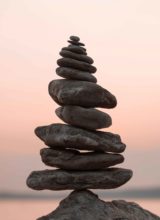
Understanding Amenorrhea and How It Affects Fertility
Amenorrhea is defined as the absence of menstruation in a pre-menopausal woman. If no menstruation occurs by age 16, it is called “primary amenorrhea.” Whereas “secondary amenorrhea” is the stoppage of menstruation for more than three months when there is no confirmed pregnancy, menopause, or breast feeding involved. Secondary amenorrhea can be caused by elevated prolactin or androgens, Hypothyroidism, Hypopituitarism, extreme exercise, extreme weight loss or eating disorders, stress or psychological disorders, or improper functioning of the ovaries. The most common symptoms are the cessation of menses, nausea, swollen breasts, headaches, and goiters.
Since normal menstrual cycles are based on a feedback system between the hypothalamus, pituitary gland, ovaries and the reaction of the uterine lining to stimulation, the goal of any treatment would be to restore this feedback system. There are many hormones involved in ensuring a proper menstruation can take place, such as: follicle-stimulating hormone (FSH), luteinizing hormone (LH), prolactin, estrogen, progesterone, androgen, and gonadotropin-releasing hormone (GnRH).
How Acupuncture and Chinese Medicine Treat Amenorrhea
In Chinese medicine the most important organs that regulate blood and menstruation are the liver, spleen, and kidneys. The kidneys are responsible for conception, reproduction, and egg quality. The spleen and liver control the amount of nutrients and the smooth flow of the hormones. Nurture Acupuncture treats patients with Amenorrhea based on an individualized assessment of their particular condition and custom tailors an appropriate and effective treatment plan.
Acupuncture promotes proper hormonal balance and regulates the Hypothalamus-Pituitary-Ovarian axis by stimulating blood flow to the reproductive organs and the brain. It also relaxes the body and reduces stress levels (elevated stress can prohibit menstruation by blocking blood flow to the reproductive organs and causing an imbalance in hormonal production).
Chinese herbs are highly individualized and help build the uterine lining and adjust the Hypothalamus-Pituitary-Ovarian axis. This rebalance helps regulate and improve the body’s natural hormonal production which in turn aids in proper menstruation. And, Chinese herbs nourish the spleen, liver, and kidney system which are responsible for our reproductive health.
Reproductive organ massage (ROM) is a highly specialized form of therapeutic massage that manipulates the fascia of the pelvic cavity to improve blood circulation to the ovaries and to establish a better connection between the pituitary and the ovary. Therapeutic massage may improve endocrine function by relieving stress and increasing pelvic blood flow.
Nutritional guidance is customized for each patient based on the health of her kidney, liver, and spleen functions, which control our reproductive health and underlie our metabolic processes. For patients with Amenorrhea, we recommend eating a quality diet of whole grains, organic vegetables and fruits, lean meats, and less sugar and junk food to help balance the hormones and restore proper menstrual function. Additionally, you should increase your intake of calcium, vitamins A, C, D, E, K, boron, zinc, selenium, B6, and essential fatty acids.
How Western Medicine Treats Amenorrhea
The normal protocol in Western medicine is to prescribe hormone therapy or birth control pills to regulate the menstrual cycle. Western medicine can treat the problem but cannot cure the cause.
Research and Related Articles on Amenorrhea
A clinical study was conducted at the Thousand Buddha Mountain Hospital in Jinan, China, to determine the efficacy of acupuncture versus medication for amenorrhea. There were 95 subjects in the study. All the patients’ amenorrhea had lasted for six months or more, and was attributed to the use of birth control pills. 57 of the patients were in the Acupuncture Treatment Group, and 38 patients were in the Medication Group. The entire treatment consisted of six courses (20 treatments in each course), with five-day breaks between the courses.
In the Medication Group, patients took Stilbestrol first, then Progesteronum was injected. One month after finishing the treatments, the effective rate (cure, great improvement and improvement) for the Acupuncture Treatment Group was 96.49%, while the effective rate for the Medication Group was 97.36%. Six months after finishing the treatments, however, the effective rate was reported at 94.73% for the Acupuncture Treatment Group, while the effective rate dropped to 78.94% for the Medication Group. This is a significant difference between the two groups, suggesting that the long-range effects of acupuncture are very positive.
Many studies in China reveal that acupuncture, moxibustion, and Chinese herbal medicine are superior to conventional medicine in the treatment of menstrual disorders, including amenorrhea.
Medical Disclaimer: The information and advice published or made available through this website is NOT intended to replace the services of a physician or a health care professional acting under a physician’s supervision, nor does it constitute a doctor-patient relationship which has been established by an in-person evaluation of a patient.
Cheong Holistic Medicine
- (604) 684-4333
- 1160 Burrard Street, Suite 405
- Vancouver, BC V6Z 2E8
- Click HERE to see us on Google Maps
- About Cheong Holistic Medicine
Clinic Hours
- Mon-Fri: 9AM – 5PM
- Sat: 9AM – 12PM
- Our clinic is quite often busy. Please make an appointment for convenience.







Send a comment